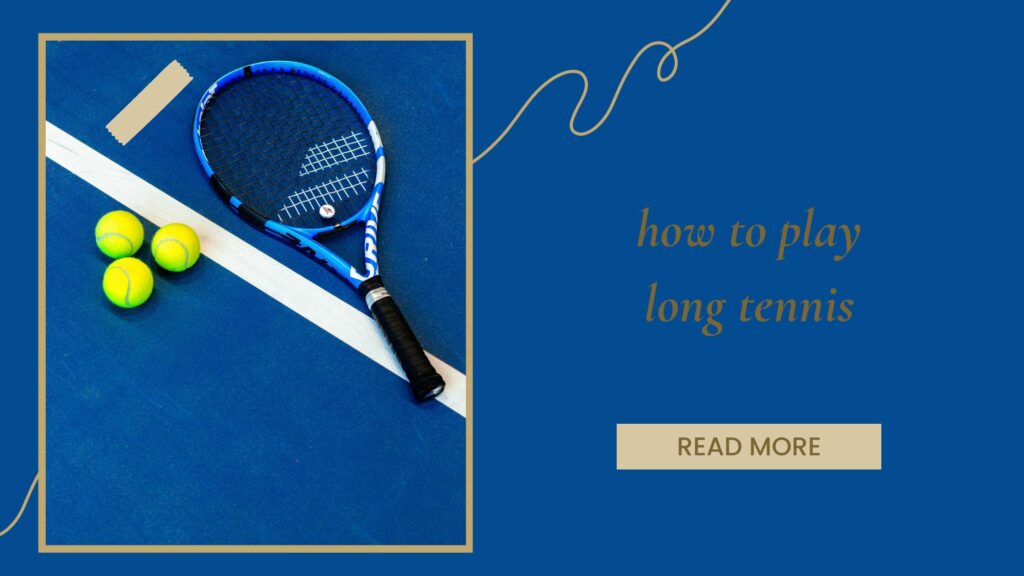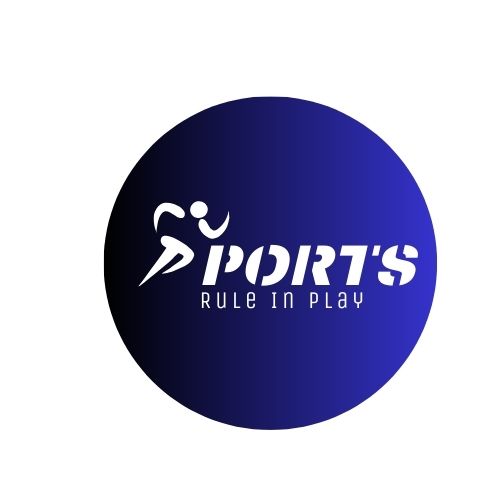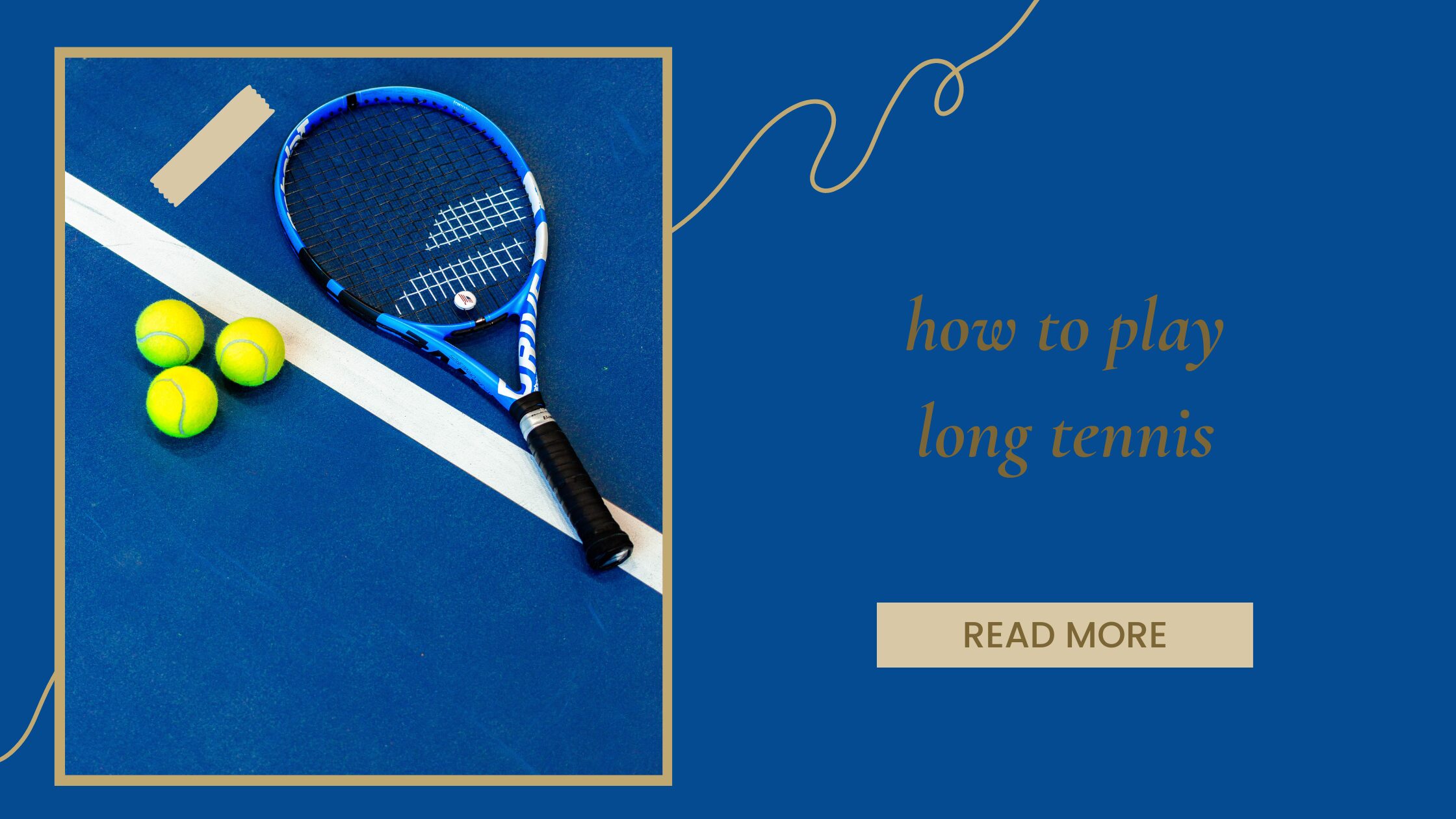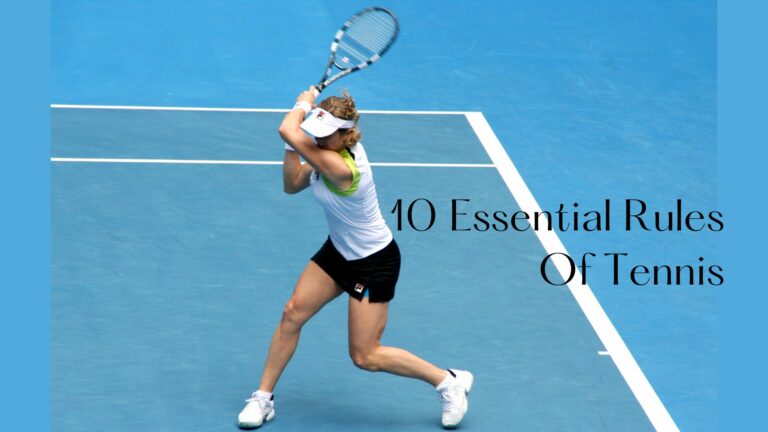how to play long tennis – Master the Fundamentals and Start Playing
Master the Fundamentals and Start Playing Today! Whether you’re a beginner looking to learn the basics or a seasoned player wanting to refine your skills, we’ve got you covered. In this blog, we’ll break down the essential techniques and strategies to help you understand how to play long tennis and enjoy the game of long tennis. So, grab your racket and let’s dive in.

how to play long tennis
Tennis is played on a court divided by a net, with each half containing service boxes from which players serve. Serving from behind the baseline, they aim to land the ball within the opponent’s service box. It’s crucial to understand scoring rules, like ‘love’ for zero points and ‘deuce’ when both players reach 40. Additionally, knowing the court dimensions, including singles and doubles sidelines, is important for effective gameplay. Understanding these fundamentals sets the stage for an enjoyable and fair tennis experience.
Navigating the Tennis Court Layout
The tennis court layout is comprised of various elements, including baselines, sidelines, service boxes, and a center service line that divides each player’s side of the court. Strategically positioning oneself to cover different areas of the court based on the opponent’s shots is crucial for success in tennis. Efficient movement between different court areas allows players to anticipate shots and swiftly react during rallies. Additionally, environmental factors like the position of the sun can influence how players navigate and adapt to the tennis court layout, adding an extra layer of complexity to the game.
Grasping the Basic Rules of Scoring
Understanding the basic scoring rules, including the ’15-30-40-game’ progression, is essential for effectively keeping track of points during matches. Knowing when to call ‘let’ or ‘out’ based on the location of the serve adds fairness to gameplay and promotes good sportsmanship. It’s also important to recognize when to change sides after odd-numbered games, ensuring equal playing conditions for both competitors throughout a match. Additionally, familiarizing oneself with rules regarding faults, double faults, and challenges contributes to maintaining a fair and respectful atmosphere on the court, allowing for a more enjoyable and honourable tennis experience for all players.
Mastering the Basic Techniques
Improving your tennis game involves focusing on footwork and positioning to cover the court efficiently. By practising proper grip and swing techniques, you can enhance your shot power and accuracy. Additionally, mastering the art of timing and coordination is essential for consistent performance during intense rallies. Understanding the rules of the game and developing a strategic mindset will contribute to your success on the tennis court, enabling you to approach matches with confidence and precision. With these fundamentals in place, you’ll be ready to elevate your game and enjoy the sport to its fullest potential.
Perfecting the Forehand Stroke
Mastering the fundamental techniques of tennis involves various key aspects, such as perfecting your stance and body rotation to maximize the force in your forehand shots. Additionally, focusing on a seamless motion from backswing to follow-through can significantly enhance shot accuracy. Learning the topspin technique allows you to control the ball’s trajectory with precision, adding depth to your gameplay. Anticipating your opponent’s moves and positioning yourself optimally for each shot is a crucial skill that can give you a competitive edge on the court. By mastering these techniques, you can elevate your game and approach each match with confidence and precision.
Improving the Backhand Stroke
Mastering the backhand stroke in tennis involves adjusting your grip and wrist position to ensure a comfortable and effective swing. It’s essential to practice footwork and balance to maintain stability while executing backhand shots, allowing you to cover the court efficiently. Focusing on generating power from your legs and core will result in stronger backhand hits, adding depth to your gameplay. Additionally, developing variations like slice and topspin can keep your opponents off guard, giving you a competitive edge on the court.
Mastering Serve and Return Tactics
Mastering different types of serves, such as flat, slice, and kick serves, will refine your serving technique and give you a versatile range of options on the court. By focusing on consistency and minimizing double faults, you can deliver powerful serves that keep your opponent on their toes. Analyzing your opponent’s serve patterns and adjusting your positioning will enhance your return game, setting the stage for gaining an advantage in rallies. Developing strategies for net play after a successful return will further solidify your skills and overall performance on the tennis court.
Developing Your Strategy
When developing your tennis strategy, it’s crucial to assess your strengths and weaknesses as a player, allowing you to tailor your approach accordingly. Focus on consistency and accuracy rather than solely aiming for powerful shots to maintain control during the game. Additionally, adapting your strategy based on your opponent’s playing style and weaknesses can provide you with a competitive edge on the court. By incorporating variety in your shots and tactics, you can keep your opponent guessing and maintain the element of surprise, further enhancing your overall performance during matches.
Mastering Serve and Return Tactics
Mastering the art of placing your serves strategically and honing your return tactics is essential to gaining an advantage on the tennis court. By anticipating the trajectory of the ball and positioning yourself optimally, you can counteract with effective shots, keeping your opponent on their toes. Employing deceptive tactics during serves and returns adds an element of surprise, catching your opponent off guard during crucial moments in the game. Additionally, focusing on maintaining a balance between aggression and consistency in your tactics will keep your opponent under pressure and maximize your chances of winning points.
Understanding Positioning and Movement on the Court
Understanding the importance of positioning yourself effectively on the court is crucial in covering potential openings and anticipating your opponent’s moves. Mastering footwork techniques enables you to swiftly move across the court, ensuring that you are always ready to reach the ball with optimal positioning. It’s essential to utilize efficient movement patterns based on the situation, whether it’s approaching the net or defending from the baseline, to maintain control over each point. Additionally, staying mindful of court positioning while transitioning from defensive play to offensive play allows you to capitalize on scoring opportunities, giving you an edge in every match.
Mastering the Grip
Understanding the proper grip in tennis is fundamental for executing powerful and precise shots on the court. Achieving the correct hand positioning and pressure is crucial in mastering the grip, as it directly impacts your control and spin when striking the ball. A strong grip not only enhances control but also facilitates the generation of spin, adding depth and unpredictability to your strokes. To master the grip, consistent practice and dedicated focus on technique are essential. By prioritizing the refinement of your grip, you can significantly elevate your overall performance and maneuverability during matches.
Understanding the Continental Grip
Understanding the continental grip is crucial for developing a well-rounded tennis game. This versatile grip is commonly used for volleys, serves, and overheads, providing players with the ability to handle different types of shots with ease and precision. It involves placing the base knuckle of your index finger on bevel number two of the racket handle, allowing for effective control and maneuverability on the court. Whether you’re looking to enhance your net game or refine your serving technique, mastering the continental grip is an essential aspect of elevating your overall performance in tennis.
Perfecting the Eastern Forehand Grip
Mastering the eastern forehand grip is crucial for any tennis player looking to enhance their forehand shots. By positioning your base knuckle against bevel number three on the racket handle, you can achieve both stability and power in your strokes. This grip also enables players to generate considerable topspin while maintaining control over their shots, making it a fundamental aspect of executing effective forehand strokes on the court. Prioritizing the refinement of this grip will undoubtedly elevate your overall performance and maneuverability during matches.
Footwork and Positioning
Mastering footwork techniques is a fundamental aspect of excelling in tennis. By understanding the importance of proper footwork, players can efficiently cover the court while conserving energy, allowing them to anticipate their opponent’s moves and respond strategically. Good footwork not only enables players to execute various shots with power and precision but also ensures that they maintain balance during every shot. With the right positioning and footwork, players can maximize their performance on the court while minimizing wasted energy, ultimately giving them an edge in every match they play.
Importance of Proper Footwork
Mastering footwork techniques is a fundamental aspect of excelling in tennis. Proper footwork enhances a player’s agility, allowing them to move quickly and smoothly around the court. It contributes to better-shot execution by ensuring that players are in the optimal position for each shot. Effective footwork reduces the risk of injury by promoting balanced movement and stability on the court. Additionally, players with good footwork can maintain their performance level throughout long matches, showcasing consistency in their game. By prioritizing footwork, players can maximize their performance while minimizing wasted energy, ultimately giving them an edge in every match they play.
Optimizing Court Positioning for Success
Optimizing court positioning is a crucial element in gaining a strategic edge on the tennis court. By anticipating opponents’ shots and adjusting one’s position accordingly, players can effectively control points and make it challenging for opponents to hit winners. Proper positioning not only allows players to exploit their opponent’s weaknesses but also maximizes their own strengths during rallies. This strategic approach puts pressure on opponents, leading to forced errors and creating opportunities to seize control of the point. Mastering the art of court positioning can undoubtedly elevate a player’s performance and competitive advantage on the court.
Powerful Serve Techniques
Improving your serve in tennis involves focusing on generating power from your legs and core, rather than solely relying on arm strength. Experimenting with different grip styles is also key to finding the one that enables you to achieve maximum power and control. Additionally, maintaining a relaxed wrist during the serve can enhance snap and speed upon contact with the ball. It’s equally important to practice a consistent toss by releasing the ball at the same height and spot for every serve, which ultimately develops accuracy and precision in your game.
Developing a Consistent Toss
Mastering the art of serving in tennis begins with honing your tossing technique. Start by practicing your toss without hitting the ball, focusing solely on releasing it consistently at the desired height. Visualize an imaginary target above the net as you toss the ball to ensure a consistent trajectory for each serve. Avoid overreaching or under-tossing the ball by using your non-racket hand as a guide for a consistent release point. Additionally, utilize drills specifically designed to improve your tossing technique and enhance overall serving consistency. By prioritizing the refinement of your toss, you’ll lay a strong foundation for a powerful and precise serve.
Maximizing the Impact of Your Serve
When working to enhance your serve in tennis, it’s essential to integrate body rotation into your motion to optimize power, reducing the reliance on arm strength alone. Additionally, varying your serve placement and speed can disrupt opponents’ rhythm, enhancing the overall effectiveness of your serves. Visualizing a specific target on the opponent’s side can significantly improve accuracy and elevate your impact during matches. Consider utilizing video analysis tools or seeking feedback from a coach to pinpoint areas for improvement in your serve technique, ultimately refining your overall impact on the court.
Effective Volley Strategies
Improving your volley game in tennis involves focusing on maintaining a relaxed grip on the racket to enhance control and accuracy. Additionally, positioning yourself at the net with your non-racket shoulder pointing towards the opponent’s side allows you to cover more ground effectively, gaining an advantage in the game. Utilizing short backswings when volleying is crucial for maintaining quick reflexes and responsiveness, essential for dominating the net. To keep opponents off balance and guessing, incorporating unpredictable placement of volleys is a strategic approach that can elevate your performance on the court.
Mastering the Art of the Volley
Mastering the art of volleying in tennis requires dedicated practice to perfect your form and timing. One effective method is to practice shadow swings, allowing you to focus on your technique and timing without the distraction of a ball. Additionally, maintaining a low, athletic stance is crucial for being prepared for the rapid movements required at the net. Focus on finesse over power, redirecting the ball with precision rather than solely relying on force. Anticipating your opponent’s shots is also essential, so staying light on your feet and ready to react swiftly will give you an edge in mastering volleys.
Utilizing Angles and Touch at the Net
To elevate your game, strategically use angles and aim for deep corners or sharp cross-court shots to capitalize on your opponent’s positioning. Additionally, developing a delicate touch is crucial, so practising soft hands drills with gentle volleys close to the net can enhance your finesse. Furthermore, keeping your opponents guessing and under pressure is key, so vary your shot selection with drop volleys and lobs. Lastly, exercising patience at the net and waiting for opportunities to pounce, rather than forcing risky shots, can significantly impact your performance on the court.
Winning Groundstroke Tactics
Mastering the art of groundstrokes in tennis involves a combination of strategic tactics. By prioritizing proper footwork, you can swiftly position yourself for each shot, gaining a significant advantage on the court. Varying the speed and placement of your groundstrokes adds an element of unpredictability, keeping your opponent off balance and unable to anticipate your next move. Additionally, incorporating a mix of topspin and flat groundstrokes into your repertoire adds depth to your game, making it more challenging for your opponent to read your shots. Furthermore, the ability to maintain a strong court position after executing a groundstroke is essential, allowing you to quickly recover and prepare for the next shot, maintaining control throughout the match.
Perfecting the Forehand and Backhand
Perfecting your forehand and backhand strokes in tennis requires attention to detail and consistent practice. When focusing on the forehand, it’s essential to pay close attention to your grip, stance, and generating power through hip rotation. For the backhand, mastering both one-handed and two-handed techniques can provide versatility in various game situations. To enhance the accuracy and control of both shots, consistent practice with a variety of drills is crucial. Remember to maintain a relaxed grip and fluid motion for both strokes to minimize tension and enhance overall consistency on the court.
Utilizing Topspin and Slice Techniques
Mastering the art of topspin and slice shots in tennis involves focusing on the nuances of racket angle, swing path, and follow-through for precise execution. To effectively utilize topspin, brushing up on the ball with an upward motion while maintaining a steady contact point in front of your body is crucial. On the other hand, when incorporating slice techniques, using an open racket face and brushing down the back of the ball creates underspin for low, skidding shots. To further refine these skills, practice hitting various targets on the court with both topspin and slice to develop accuracy and control over these specialized groundstroke techniques.
Choosing the Right Equipment
When it comes to gearing up for tennis, selecting the right racket and footwear is key to optimizing your performance on the court. Start by considering the head size, grip size, and weight of the racket to find one that complements your playing style. Additionally, take the time to understand the various string tension options available, as this can significantly impact the control and power of your shots. As for footwear, prioritize comfort, cushioning, stability, and durability when selecting tennis shoes. Remember, trying out different rackets and shoes before making a purchase is crucial to ensuring the perfect fit for your game.
Selecting the Perfect Racket
Selecting the ideal tennis racket is crucial to elevating your game and overall enjoyment on the court. Factors such as head size, grip, and weight play a pivotal role in determining the right fit for your skill level and playing style. Seeking guidance from seasoned players or professionals can provide valuable insights into choosing a racket that aligns with your individual needs. Additionally, testing out different rackets allows you to gauge how each one enhances your performance in terms of power, control, and comfort, ultimately leading to a more informed decision.
Picking the Right Tennis Shoes
When selecting tennis shoes, it’s essential to prioritize ample cushioning, ankle support, and a reliable grip to facilitate quick movements on the court. Ensuring a comfortable fit, especially during lateral movements, is crucial to prevent blisters or discomfort while playing. Additionally, consider factors such as shoe material, outsole pattern, and ventilation to find a pair that aligns with your performance needs and comfort preferences. Seeking guidance from an expert at a sports store can provide valuable insights into selecting tennis shoes tailored to your unique foot shape and playing style.
Staying Fit and Preventing Injuries
Regular cardiovascular exercise, whether it’s running or swimming, is crucial for maintaining overall fitness and preventing injuries. By incorporating strength training into your workout routine, you can effectively build muscle and support joint stability, thus reducing the risk of injuries during physical activities. Additionally, proper nutrition plays a pivotal role in staying fit and preventing injuries by providing the body with essential nutrients for recovery and energy. Lastly, getting an adequate amount of rest and sleep is equally important for injury prevention as it allows the body to repair and rejuvenate after physical exertion. All these factors work synergistically to help you stay fit and active while minimizing the risk of injuries.
Effective Warm-up and Stretching Routines
Before diving into a game of tennis, it’s important to kickstart your body with a thorough warm-up. Integrate light aerobic exercises such as jogging or jumping jacks to get your blood flowing, preparing your muscles for action. Enhance your flexibility and reduce the risk of strains by adding dynamic stretching to your routine. To specifically target tennis-related movements, focus on shadow swings and footwork drills during your warm-up to prep your body for the demands of the sport. After your game, don’t forget to incorporate static stretches to improve flexibility and alleviate muscle tightness.
Injury Prevention and Recovery Tips
Mastering the fundamentals of tennis involves not only perfecting your strokes and strategies but also prioritizing injury prevention. By utilizing proper technique and form, you can minimize the risk of overuse injuries such as tennis elbow and shoulder strains. Additionally, allowing for sufficient rest between training sessions and matches is crucial for your body to recover, reducing the likelihood of chronic injuries. Moreover, applying ice to acute injuries right after they occur can aid in reducing inflammation and relieving pain, ultimately speeding up the recovery process. Seeking guidance from a sports medicine specialist or physiotherapist can also offer valuable insights into tailored injury prevention strategies, ensuring you stay healthy and active on the court.
Wrapping Up
Mastering the fundamentals of tennis is a rewarding journey that encompasses a wide range of skills and strategies. From understanding the layout of the court and the basic rules of scoring to perfecting your strokes and developing effective strategies, each aspect contributes to your growth as a tennis player. Additionally, the importance of selecting the right equipment, staying fit, and preventing injuries cannot be overstated. By prioritizing proper technique, seeking expert guidance, and incorporating injury prevention and recovery tips, you can elevate your game while enjoying the thrill of playing tennis. So, embrace the challenge, stay determined, and remember to have fun on the court







